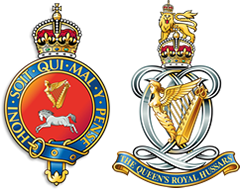a brief history of the 8th king’s royal irish hussars
In 1693 Colonel Conyngham raised a Regiment of Dragoons in Ireland. The first active service of these 8th Hussars was during the War of Spanish Succession where they defeated a Spanish Cavalry Corps and to add insult to injury, stole their crossbelts and killed them with their own swords. They were afterwards known as the “Crossbelt Dragoons”, and the Regimental Journal is still called “The Crossbelts”.
After service in England which saw extensive action to suppress the 1745 Rebellion, The 8th Hussars enjoyed a quieter period until the start of the Napoleonic Wars. The Regiment distinguished itself in the 1794 Flanders Campaign although at a very high price and then continued with active duty in South Africa and Egypt.
The 8th Hussars served alongside The 4th in the Crimea, and also charged with the fateful Light Brigade, successfully breaking up the Russian counter-attack which followed.
The Regiment was then sent to India to help with the murderous Bengal Sepoy Mutiny. In 1858, a Squadron of The 8th Hussars charged a vastly superior enemy force at Gwalior winning four Victoria Crosses in the process. A fifth Victoria Cross was added at the Battle of Beejapore a few months later. Central India 1857-58 became a Battle Honour for the Regiment.
The 8th Hussars were stationed once more in India when the Great War broke out. Like The 3rd and 4th Hussars, they spent the duration of the war winning the bitter struggle on the Western Front. For almost all of the war, the Regiment was confined to the trenches, however at Villers-Faucon, D Squadron managed to mount the last heroic charge of The 8th Hussars in 1917. The last mounted parade of the Regiment was on Armistice Day in 1938.
With the outbreak of the Second World War, the Regiment found itself fighting alongside The 3rd, 4th and 7th Hussars in all the great battles of the Desert Rats. In addition The 8th Hussars landed in Normandy in June 1944 and fought all the way across Europe to Hamburg with the Allied advance.
In 1950 The Regiment was sent to the aid of the UN forces in Korea, only to find them in full retreat before the more numerous Chinese forces. The UN force gradually took up the offensive again and The Regiment fought gallantly in the Battle of Imjin river and the actions around Seoul and Kowant-San before returning to Germany in 1952.
In 1958, The 8th Hussars amalgamated with The 4th Hussars to form The Queen’s Royal Irish Hussars.
